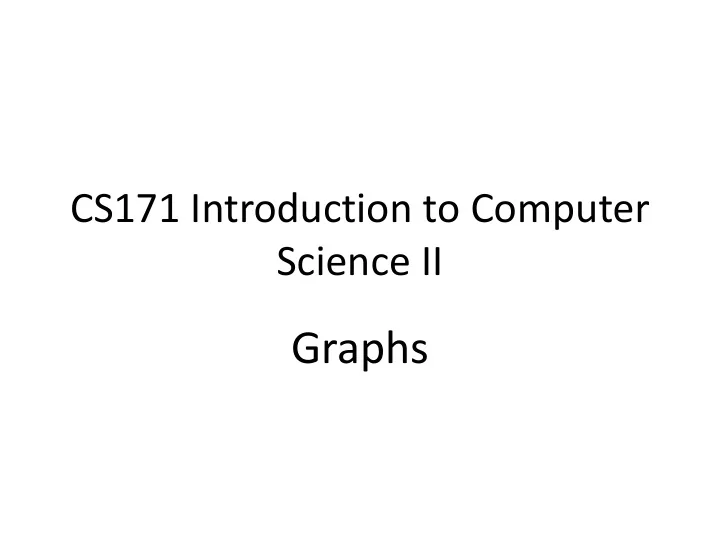

CS171 Introduction to Computer Science II Science II Graphs
Graphs � Simple graphs � Algorithms � Depth-first search � Breadth-first search � shortest path � shortest path � Connected components � Directed graphs � Weighted graphs � Shortest path � Minimum spanning tree
Dijkstra’s algorithm � Maintain a queue of nodes to be examined (open set) � Remove the node with shortest distance to the source to the closed set and add its the source to the closed set and add its neighbors to the open set
Shortest Paths – Dijkstra’s Algorithm � Initialization � Assign to every node a distance value: set it to zero for source node and to infinity for all other nodes. � Mark all nodes unvisited, insert source node into a queue (open set) � Repeat until the queue is empty Repeat until the queue is empty � Remove a node from the queue with the smallest distance from the Remove a node from the queue with the smallest distance from the source node as the "current node“ and mark it as visited (closed set) � For current node, consider all its unvisited neighbors (not in the closed set) and calculate their tentative distance . � If this distance is less than the previously recorded distance, overwrite the distance and update the parent for the neighbor, and add the neighbor into the queue or update its distance if it is already in the queue (edge relaxation)
Data structures � Distance to the source: a vertex-indexed array distTo[] such that distTo[v] is the length of the shortest known path from s to v � Edges on the shortest paths tree: a parent- � Edges on the shortest paths tree: a parent- edge representation of a vertex-indexed array edgeTo[] where edgeTo[v] is the parent edge on the shortest path to v
Dijkstra’s algorithm
From Dijkstra to A* � Dijkstra: remove the node with shortest distance from the source � A*: remove the node with shortest distance from the source and likely the shortest distance to the target � f(n) = g(n) + h(n) � g(n) = “cost from the starting node to reach n” � h(n) = “estimate of the cost of the cheapest path from n to the goal node” goal node” h(n) h(n) 20 g(n) 15 n 10 5 15 18 20 25 33
Properties of A* � A* generates an optimal solution if h(n) is an admissible heuristic and the search space is a tree: � h(n) is admissible if it never overestimates the cost to reach the destination node • A* generates an optimal solution if h(n) is a consistent heuristic and the search space is a graph: search space is a graph: – h(n) is consistent if for every node n and for every successor node n’ of n: h(n) ≤ c(n,n’) + h(n’) h(n) n d c(n,n’) h(n’) n’ • If h(n) is consistent then h(n) is admissible • Frequently when h(n) is admissible, it is also consistent
Admissible Heuristics � A heuristic is admissible if it is optimistic, estimating the cost to be smaller than it actually is. � MapQuest: h(n) = “Euclidean distance to destination” is admissible as normally cities are not connected by roads that make straight lines
Shortest Paths – A* Algorithm � Initialization � Assign to every node a distance value: set it to zero for source node and to infinity for all other nodes. � Mark all nodes unvisited, compute the cost (distance + estimate cost) for source node, and insert it into a queue (open set) � Repeat until the queue is empty � Repeat until the queue is empty � Remove a node from the queue with the smallest cost as the "current node“ and mark it as visited (closed set) � For current node, consider all its unvisited neighbors (not in the closed set) and calculate their tentative distance. � If this distance is less than the previously recorded distance, overwrite the distance and update the parent for the neighbor, and compute the cost (distance + estimated cost) for the neighbor, and add the neighbor into the queue or update its cost if it is already in the queue (edge relaxation)
Graphs � Simple graphs � Algorithms � Depth-first search � Breadth-first search � shortest path � shortest path � Connected components � Directed graphs � Weighted graphs � Shortest path � Minimum spanning tree
Applications � Phone/cable network design – minimum cost � Approximation algorithms for NP-hard problems
Recommend
More recommend